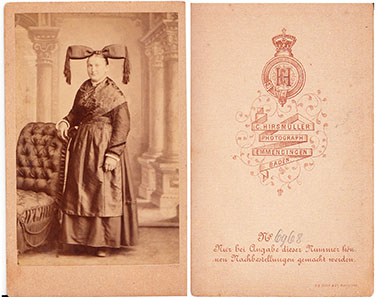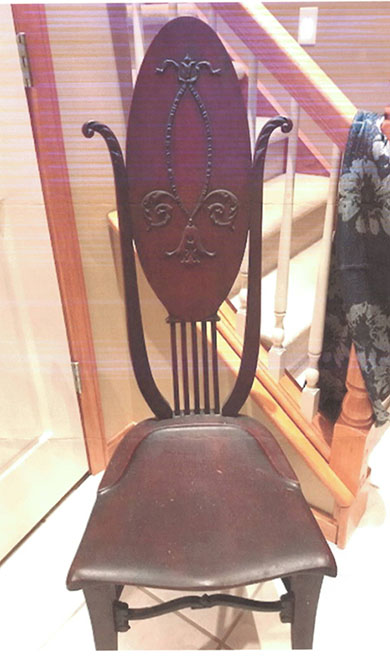 |
|
|||
 |
 |
|||
Copyright © Harry Rinker, LLC 2017 Questions
and Answers
QUESTION: In a box lot I recently purchased at auction, I found a carte de visite (2 1/2-inches by 4-inches) of a young German woman in ethnic garb. The woman is wearing a very unusual hat. It appears to be an elongated bow with a cloth drop at each end. The back of the card is marked; C. HIRSMÜLLER / PHOTOGRAPH / EMMENDINGEN / BADEN / NO. 6968 / Nur bei Angabe dieser Nummer kön- / nen Nachbbestellungen gemacht warden.” I am totally confused as to what ethnicity or fashion statement is represented by her clothes and hair piece. – BM, Kent, OH, Email Question 
ANSWER: Emmendingen, a town in Baden-Wüttemburg, is the capital city of the Emmendingen district of Germany. Emmendingen is located on the Elz River, 14 kilometers (8.7 miles) north of Freiburg in Breisgau. Breisgau is located between the foothills of the Black Forest and the Kaiserstuhl, rising from the Rhine plain to the north of Freiburg. The number “6968” is a glass plate negative number. The text beneath it translates roughly as “Subsequent orders can only be made if this number is specified.” Having traveled extensively in Germany, I am aware that German regions, even municipalities, have different historic tracht (folk dress) for men and women. These costumes identify a region, religion, and/or material status. Further, each region’s dress divides into workday, festival, Sunday, and wedding subcategories. The young lady in the carte de visite is wearing Markgräfler Tracht, detailed information for which can be found on de.wikipedia.org/wiki/Markgräfler_Tracht or www.markgraefler.de/region/tradition-und-brauchtum/trachten. A distinctive head cover for the Emmendingen region was first documented in the late seventeenth century. The “winged” cap arrived on the scene in the 1820s. As the nineteenth century progressed, the wings grew larger and tassels started to appear on the ends. By 1890, the Markgräfler “horn” cap featuring long bows and long fringes was fully developed. The tradition prevailed until the early 1930s. The folk costume was worn by the rural population for fest days, holidays, and Sundays. Today, costume clubs in the area have revived the tradition. Your carte de visite only has curiosity value in the United States. It would be priced between $3.00 and $5.00 at a flea market or antiques mall. Value to a member of an Emmendingen region costume club is much higher, as much as 12 to 15 Euros. QUESTION: My wife and I recently bought a home for our son. The former owner left behind a chair. The chair has a cabriole-like leg, a saddle seat with a relief “U” on the back half. The back features two extended stiles, each ending in a wave-like, fern frond top section. The back is a large oval with an applied relief design of a central oval garland chain with a curled wave top featuring a central flower above a squiggly line and at the bottom of the oval a bellflower with a fern-like curl to the left and right above it at the base of the oval garland. The oval is supported by five horizontal bars that attach at the bottom to the seat. Can you date the chair? Should this chair be insured? – JC, Chagrin Falls, OH, Letter 
ANSWER: The chair dates from the first two decades of the 20th century. Stylistically, it defies classification. It contains elements from a number of classic furniture design style, typical of many generic, functional pieces made during that period. At one point, it probably was part of a larger set, the other chairs either taken, distributed, or discarded by the former owners. The chair is not designed to carry a great deal of weight, thus making it impractical in today’s world. The “U” on the back of the seat may have been designed to hold a seat pillow in place. There is no need to insure the chair. Its secondary market value is under $50.00. Although the chair is a conversation piece, young collectors have no interest in this style and type of furniture. When encountering pieces that previous owners left behind, I always tell the new owner that there had to be a reason why the item was left behind. In most instances, the answer becomes apparent after one quick look. QUESTION: I have a Marx Toys tabletop pinball game from 1971. The Roman numeral XMCLXXI and “Made in the USA” is on the base. The “All American Sports” surface if filled with images of individuals involved in sporting activities. The outer plastic shell of the game is damaged. Can it be restored? Is it worth restoring? The lithography on the metal surface of the game is in very good condition. – M, Reading, PA, Email Question ANSWER: Plastic covered tabletop pinball machines, known as bagatelles, were an extremely popular children’s toy from the 1950s through the early 1970s. All Marx needed to do to create a new game was design a new lithograph tin base theme. The surface image of the “All American Sports” bagatelle featured a large generic sports clock in the center beneath which is “All American” with a racing tire between “Sports. The rest of the surface has images representing a wide variety of sports. The images were created prior to Title IX. The imagery would be considered sexist in today’s politically correct environment. The only women athletes pictured are a diver and golfer. The other sports feature males performing: baseball (batter and catcher), ski jumping, a boxer, a basketball jump ball, a bowler, a hurdler, a hockey player, and a fisherman. The cost to fix the broken plastic on your “All American Sports” bagatelle is prohibitive. A new example with the plastic cover in perfect condition can be purchased for a fraction of the cost of any repair. I checked WorthPoint.com to check sell through prices for the last three years. With a little bit of patience, a replacement example can be purchased for $35.00 or less. I did find an eBay listing that sold in June 2017 for $49.99 plus shipping. The high price resulted from the fact that the bagatelle was in its period packaging. If this bagatelle was a childhood toy, you might take a “cost be damned” approach to restoring it. Do not do it. Chances are the restorer will buy an example from the internet and switch the cover. There is no way to repair plastic without the glue line being evident. If you do decide to replace the toy, search under “All American Sports pinball game” and not “All American Sports bagatelle.” I used both keyword searches with the results being 10 to 1 in favor of “pinball game.” QUESTION: I have a copy of an “Old Yeller” comic book issued by Dell in 1957. It is a pictorial presentation of a Disney movie by the same name. What is its value? – K, Schuylkill Haven, PA ANSWER: Disney’s “Old Yeller” was released on December 25, 1967. The movie starred Tommy Kirk, Dorothy McGuire, and Beverly Washburn. The story was based on Fred Gipson’s “Old Yeller!” which won the prestigious Newberry award in 1956. Gipson and William Tunberg wrote the script. The movie, set in the 1860s following the end of the Civil War, is about a boy and his relationship with his dog. It was common practice in the 1950s through the 1970s to create comic book spinoffs for family oriented movies. Disney was not the only studio that did this. The cover price for the Dell “Old Yeller” comic was 12-cents. Its number code was “869.” The comic book was copyrighted January 1958. Condition is critical when pricing comics. Grading condition is difficult for someone unfamiliar with the process. A faded cover, browning pages, turned edge, tear, or writing on the cover have a major impact on value. Demand also plays a role. Demand for the “Old Yeller” comic is minimal. Copies in good condition sell for $5.00. Copies in fine condition bring between $10.00 and $15.00. Harry L. Rinker welcomes questions from readers about
collectibles, those mass-produced items from the twentieth and twenty-first centuries.
Selected letters will be answered in this column.
Harry cannot provide personal answers.
Photos and other material submitted cannot be
returned.
Send your questions to: Rinker on Collectibles, 5955 Mill
Point Court SE, Kentwood, MI 49512.
You also can e-mail your questions to
harrylrinker@aol.com.
Only e-mails containing a full name and mailing address
will be considered.
You can listen
and participate in
WHATCHA GOT?, Harry’s
antiques and collectibles radio call-in show, on Sunday mornings between 8:00 AM
and 10:00 AM Eastern Time.
If you
cannot find it on a station in your area,
WHATCHA GOT?
streams live on the Internet at www.gcnlive.com.
|
||||